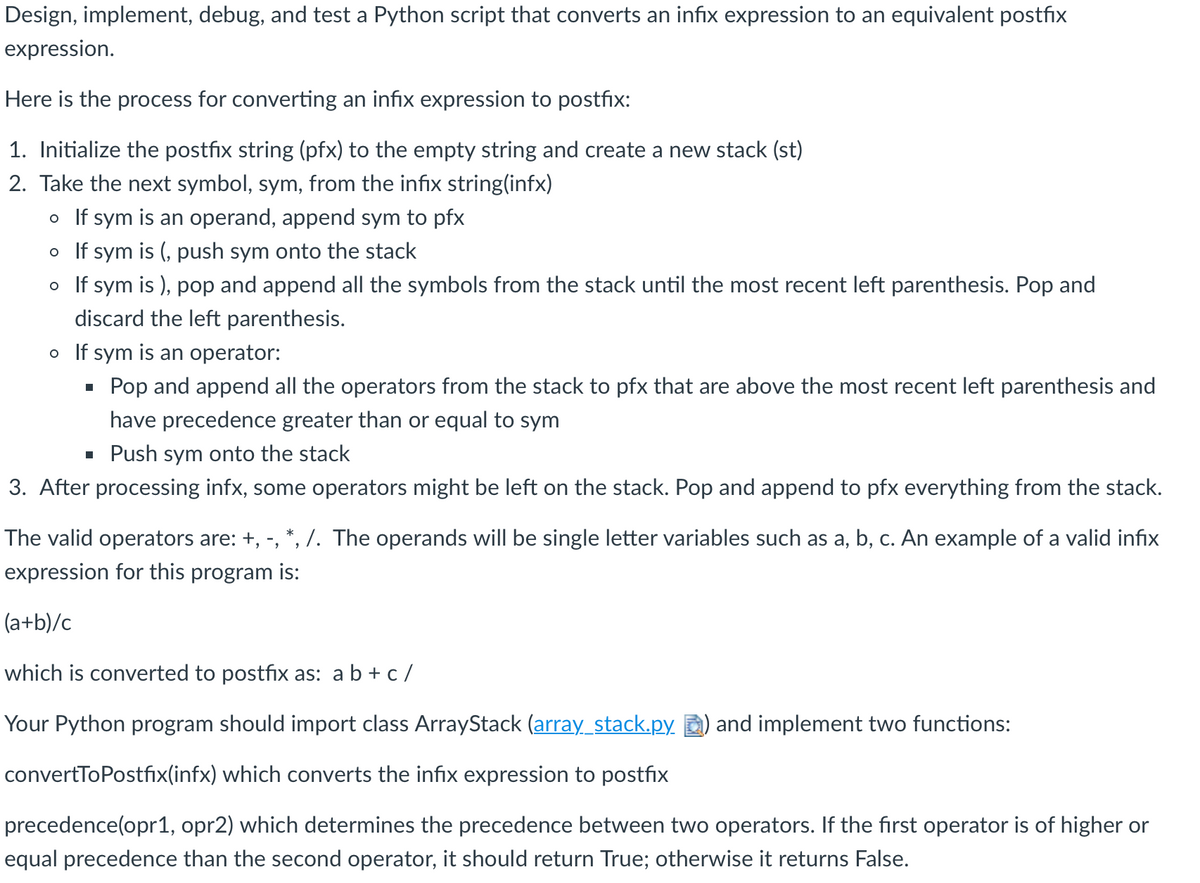class ArrayStack: """LIFO Stack implementation using a Python list as underlying storage.""" def __init__(self): """Create an empty stack.""" self._data = [] # nonpublic list instance def __len__(self): """Return the number of elements in the stack.""" return len(self._data) def is_empty(self): """Return True if the stack is empty.""" return len(self._data) == 0 def push(self, e): """Add element e to the top of the stack.""" self._data.append(e) # new item stored at end of list def top(self): """Return (but do not remove) the element at the top of the stack. Raise Empty exception if the stack is empty. """ if self.is_empty(): raise Empty('Stack is empty') return self._data[-1] # the last item in the list def pop(self): """Remove and return the element from the top of the stack (i.e., LIFO). Raise Empty exception if the stack is empty. """ if self.is_empty(): raise Empty('Stack is empty') return self._data.pop() # remove last item from list def precedence(opr1, opr2): def convertToPostfix(infx): pfx = '' stack = [] elif sym = "+" or "-" or "/" or "*": for j in range(len(stack)): if stack.top() if __name__ == '__main__': S = ArrayStack() # contents: [ ] S.push(5) # contents: [5] S.push(3) # contents: [5, 3] print(len(S)) # contents: [5, 3]; outputs 2 print(S.pop()) # contents: [5]; outputs 3 print(S.is_empty()) # contents: [5]; outputs False print(S.pop()) # contents: [ ]; outputs 5 print(S.is_empty()) # contents: [ ]; outputs True S.push(7) # contents: [7] S.push(9) # contents: [7, 9] print(S.top()) # contents: [7, 9]; outputs 9 S.push(4) # contents: [7, 9, 4] print(len(S)) # contents: [7, 9, 4]; outputs 3 print(S.pop()) # contents: [7, 9]; outputs 4 S.push(6) # contents: [7, 9, 6] S.push(8) # contents: [7, 9, 6, 8] print(S.pop()) # contents: [7, 9, 6]; outputs 8 I have the instructions attached. I'm not looking for an answer, just a better undertsanding of how to execute this project. I have tried different methods to implement the two functions. I have yet to creat a main class file but I can mange that. I just want to know how I can apprach this code is a more effective way. The pseudo code given in the instructions is quite confusing.
This is what i have for array stack to far:
from exceptions import Empty
class ArrayStack:
"""LIFO Stack implementation using a Python list as underlying storage."""
def __init__(self):
"""Create an empty stack."""
self._data = [] # nonpublic list instance
def __len__(self):
"""Return the number of elements in the stack."""
return len(self._data)
def is_empty(self):
"""Return True if the stack is empty."""
return len(self._data) == 0
def push(self, e):
"""Add element e to the top of the stack."""
self._data.append(e) # new item stored at end of list
def top(self):
"""Return (but do not remove) the element at the top of the stack.
Raise Empty exception if the stack is empty.
"""
if self.is_empty():
raise Empty('Stack is empty')
return self._data[-1] # the last item in the list
def pop(self):
"""Remove and return the element from the top of the stack (i.e., LIFO).
Raise Empty exception if the stack is empty.
"""
if self.is_empty():
raise Empty('Stack is empty')
return self._data.pop() # remove last item from list
def precedence(opr1, opr2):
def convertToPostfix(infx):
pfx = ''
stack = []
elif sym = "+" or "-" or "/" or "*":
for j in range(len(stack)):
if stack.top()
if __name__ == '__main__':
S = ArrayStack() # contents: [ ]
S.push(5) # contents: [5]
S.push(3) # contents: [5, 3]
print(len(S)) # contents: [5, 3]; outputs 2
print(S.pop()) # contents: [5]; outputs 3
print(S.is_empty()) # contents: [5]; outputs False
print(S.pop()) # contents: [ ]; outputs 5
print(S.is_empty()) # contents: [ ]; outputs True
S.push(7) # contents: [7]
S.push(9) # contents: [7, 9]
print(S.top()) # contents: [7, 9]; outputs 9
S.push(4) # contents: [7, 9, 4]
print(len(S)) # contents: [7, 9, 4]; outputs 3
print(S.pop()) # contents: [7, 9]; outputs 4
S.push(6) # contents: [7, 9, 6]
S.push(8) # contents: [7, 9, 6, 8]
print(S.pop()) # contents: [7, 9, 6]; outputs 8
I have the instructions attached. I'm not looking for an answer, just a better undertsanding of how to execute this project. I have tried different methods to implement the two functions. I have yet to creat a main class file but I can mange that. I just want to know how I can apprach this code is a more effective way. The pseudo code given in the instructions is quite confusing.

Trending now
This is a popular solution!
Step by step
Solved in 3 steps with 3 images









